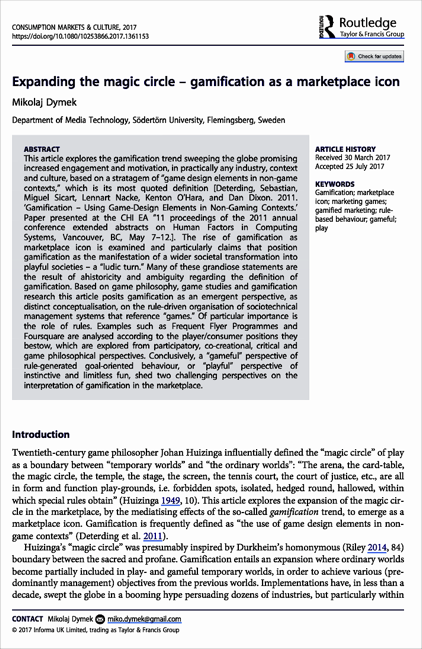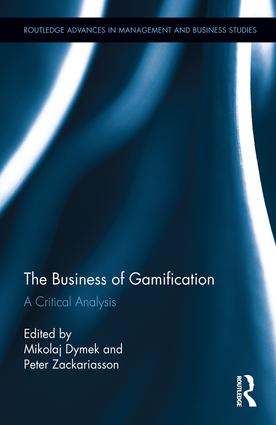CFP: Nordic DiGRA 2018
We are involved organizing the next Nordic DiGRA conference.
Below you can found the CFP. The conference web site: https://digranordic2018.w.uib.no/
We are involved organizing the next Nordic DiGRA conference.
Below you can found the CFP. The conference web site: https://digranordic2018.w.uib.no/
Our students Bachelor theses, part 2.
Our students has been doing some great stuff in their Bachelor Thesis at 2017 (in alphabetical order).
A book edited by Petri Lankoski and Jussi Holopainen.
The design has been a study topic in various fields where design methods have been the focus of inquiry.
Design research, or design studies as it is also called, has been gaining momentum as a field of academic inquiry since the beginning of 20th century. Originally, design research focused on design methods and processes but it has moved to cover more varied research questions related to design. Current research topics include, for example, how to study design and what methods can be used to study design along with the more fundamental questions such as what is design in the first place and what kinds of knowledge design research produces. The topics of design research have also become more wide and varied with active research on architecture, information systems, product, service, graphic, and interaction design to name a few. Game design research, however, has received surprisingly little attention regardless of the large body of work in the more general design research.
The main aim of this book is to situate game design research within and alongside general design research. The more specific aims of the book are to:
The chapters in this collection cover various perspectives to game design research from conceptual and comparative approaches through design and evaluation methodologies to studio and developers at work studies, making it a suitable textbook for game development and game studies courses.
Table of contents:
Citation
Lankoski, P. and Holopainen, J. 2017. Game design research: An Introduction to Theory & practice. ETC Press. ISBN: 978-1-387-40836-8 (print), 978-1-387-40837-5 (online).
Available at http://press.etc.cmu.edu/index.php/product/game-design-research/ (Printed book, e-pub & Free PDF)
Artificial Intelligence (AI) is a crucial tool and often part of innovative game designs. AI in games needs to be integrated in the design to not only encompass agents, or other tools, but also tie into the architecture of a game, both in terms of world-building, such as physics in the world, as well as the rules of the game. Together this creates the game mechanics, which may result in different play dynamics depending on how it is played.
When AI and game design is modelled and developed in tandem, the level of innovation is often increased: an innovative game design may need a new type of AI architecture, and vice versa. AI as a driver for game design is gaining traction in the research community, and is sometimes referred to as “AI based game design”, “AI-assisted game design” and at other times “AI driven game design”.
Here are a few text where we have tried to describe this emerging field:
Technical Report: USCS-SOE-11-27: AI-Based Game Design: Enabling New Playable Experiences Mirjam P. Eladhari, Anne Sullivan, Gillian Smith, Josh McCoy, University of California Santa Cruz, December 2011
AI-Based Game Design Patterns, Treanor, M., Zook, A., Eladhari, M.P., Togelius, J., Smith, G., Cook, M., Thompson, T., Magerko, M., Levine, J., Smith, A. Proceedings of the 2015 Conference on the Foundations of Digital Games (FDG 2015). Monterey, CA, June 22-25, 2015.
AI-Based Games: Contrabot and What Did You Do? Cook, M., Eladhari, M.P., Smith, A., Smith, G., Thompson, T., Togelius, J. and Zook, A. Playable Demo Track, Proceedings of the 2015 Conference on the Foundations of Digital Games (FDG 2015). Monterey, CA, June 22-25, 2015.
PCG-Based Game Design Patterns, Cook,M., Eladhari, M., Nealen, A., Treanor, M., Boxerman, E., Jaffe, A., Sottosanti, P., Swink, S. CoRR abs/1610.03138 (2016)
SmartZoos is a project funded 2015–2018 by Interreg Central Baltic with the intention of creating educational location-based games for zoos in the Central Baltic region, so as to:
The project members are Tallinn University (coordinators), Södertörn University, Skansen, Korkeasaari Zoo, and Tallinn Zoo.
The tool set that has been developed within the project is based on a central server that contains the game data, maps of the zoos and all graphics used. In practice the games are limited to quizzes, but support the use of images and video for both questions and answers. The server publishes web pages that let the players both construct and answer quizzes, they are thus as device-independent as possible, only requiring a device with a web browser and position tracking. A number of test quizzes have been developed for the participating zoos and tested by school classes visiting the zoos, resulting in a number of changes of the user interface to make it easier and more enjoyable to navigate.
The work so far has been presented at the ICALT 2017 conference in the paper “Designing learning experiences in zoos: a location-based outdoor service-package”, by Terje Väljataga, Priit Tammets, Kairit Tammets, Pjotr Savitski, Kai-Mikael Jää-Aro, and Ryan Dias.
Some notes on findings:
We have learned much from this multi-party cooperation and will make use of our experiences in upcoming research projects on educational gaming.
Game design aims to solve a design problem of “how do we create this specific game?” The main goal of this process is a game; new understanding about game development and game design is merely a by-product of that process. In game design research the aim is to uncover new facts and insight about game design, design processes, or games as designed objects; that is, to gain new knowledge and understanding about game design. (Lankoski and Holopainen, forthcoming.)
Below you can read two examples of my research by design project.
Lies and Seductions (2009) is a game built around a triangular drama. The game was designed to test ideas of character-driven game design and explore game mechanics around a social conflict between characters. While artificial intelligence (AI) was not a research topic, the game required building an AI capable modeling different personalities that react to events based on their personalities and preferences.
Publications on Lies and Seductions:
In the MOGAME project (2003–2004), we studied the possibilities of mobile games that utilize the unique features of the mobile technology. The MOGAME project was design and development based research. Within the project (one of the firsts) persistent location-aware multiplayer game, The Songs of North, was build in order to study how certain game mechanics can be used in mobile games. In addition, how different limitations of mobile technology influence to the game design was studied. Pokemon GO (Niantic, 2016) uses similar game mechanics.
Publications on MOGAME
The game industry is well on its way of becoming one of the world’s biggest cultural and entertainment industries in terms of turn-over. Sweden and the Nordics is a world-leading region, which is not only reflected in remarkably many and extremely successful game developers, but also by many game developer education programmes at university level.
The game medium has many years ago left its roots in the “teenage room” behind, and is now played by a broad spectrum of gamers of all ages on practically any electronic device with a display – on computers, game consoles, mobile phones, tablets, all connected via social media.
Despite the fact that the world of video games is one of the world’s most technologically intensive industries that creates one of the most consumer engaging products on the planet, the actual knowledge of its marketing is virtually non-existent. A very select limited few percent of all video game launches have respectable sales number, an even smaller percentage generates profit. The few hit games that succeed become metaphorical super stars that absorb all the splendour in an endless, and invisible, burial ground of commercial video game failures.
This book, which targets game development students, wants to change this state by acknowledging the basic premises of the marketing field – successful marketing starts before a product has been developed, and constitutes a guiding star throughout the entire development process all the way to product launch – and well beyond that. Marketing is not only about the sales strategy of a finished product (selling “pigs in a poke”), but constitutes a fundamental dimension in all successful product development and strategy. This book aims to help game development students to realise their vision of successful video games – not only technologically, but on all other levels.

Mikolaj Dymek (2017): Expanding the magic circle – gamification as a marketplace icon, Consumption Markets & Culture
This article explores the gamification trend sweeping the globe promising increased engagement and motivation, in practically any industry, context and culture, based on a stratagem of “game design elements in non-game contexts,” which is its most quoted definition.
The rise of gamification as marketplace icon is examined and particularly claims that position gamification as the manifestation of a wider societal transformation into playful societies – a “ludic turn.” Many of these grandiose statements are the result of ahistoricity and ambiguity regarding the definition of gamification.
Based on game philosophy, game studies and gamification research this article posits gamification as an emergent perspective, as distinct conceptualisation, on the rule-driven organisation of sociotechnical management systems that reference “games.” Of particular importance is the role of rules.
Examples such as Frequent Flyer Programmes and Foursquare are analysed according to the player/consumer positions they bestow, which are explored from participatory, co-creational, critical and game philosophical perspectives.
Conclusively, a “gameful” perspective of rule-generated goal-oriented behaviour, or “playful” perspective of instinctive and limitless fun, shed two challenging perspectives on the interpretation of gamification in the marketplace.

Dymek, M., & Zackariasson, P. (Eds.). (2016). The Business of Gamification: A Critical Analysis. Routledge
Gamification has been for several years one of the most discussed topics and concepts within the worlds of IT, management and marketing. In essence gamification is about “applying game mechanisms in non-game contexts” in everything from health care, education, management strategies through loyalty programmes, marketing and communication campaigns, psychology, sustainability, to, of course, different kinds of apps, exercise programmes, intranets, language learning tools, crowdsourcing, as well as (subtly) in most social media design.
The almost exuberant claim to swiftly transform everyday chores into enjoyable game activities, has captivated many parts of society to experiment with this novel notion – sometimes mobilised by shimmering utopian visions of a new, innovative and playful, but equally responsible and productive, everyday life. The downside is, however, that few people actually now how gamification can be created, an even smaller number of successful implementations exist – and in the murky behind-the-scenes looms a rather dismal view of humans in the character of consumers/employees/citizens as obedient pawns for the invisible and powerful game makers that hide behind playful, glitzy and trendy gamification façades.
The Business of Gamification – A Critical Analysis is one of the first edited volumes in the intersection between gamification studies and business. In this volume, edited by Mikolaj Dymek and Peter Zackariasson, various prominent researchers from around the world analyse gamification within leadership, project management, management and organisation, marketing, retailing, online forums, marketing communications, sustainability – but also critical perspectives that fundamentally question the gamification notion as such and instead paint a dystopian vision where every aspect of our everyday lives become part of one omnipresent gamified life environment.
This edited volume is not only relevant for researchers, but for anyone interested in the notion, and expects a critical examination of the biggest IT and management trends of the last decade.
« Previous 1 2 3 4 Next »